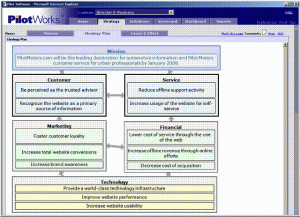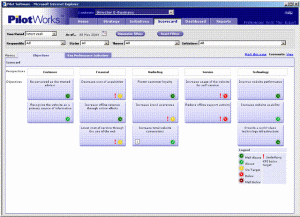For many years, I’ve argued that performance management is not just limited to finance but instead has many flavors, including workforce, operational, and IT performance management. Most people now seem to agree and there’s even talk of pervasive performance management. However, a critical analysis of the current situation suggests that marketing organizations are still early on in their adoption cycle of performance management. As a recent Gartner report commented,
Marketing may be one of the largest budgetary items in most organizations, but it is still viewed as a cost center. Developing a marketing performance management framework can improve measurability, make marketing more accountable and align its activities with corporate objectives.
I’m not talking about marketing metrics – there are plenty of those – but rather explicit definitions of strategy and objectives. Nowhere is the disconnect between metrics and strategy more obvious than for the Web site. We are awash with solutions that measure Web site performance but very few that connect these measurements to Web strategy. We need Web channel performance management.
Admittedly, this isn’t a new idea for me. In my previous job, we built a product that applied the Balanced Scorecard methodology to Web site strategy. Rather than exclusively focus on Web site traffic metrics, we provided libraries of objectives for typical Web channel business models, including brand/awareness building, lead generation, and customer support. This is what a typical strategy map might look like:
It was a good idea and a solid product but ahead of its time. Despite favorable reviews, the product never really took off.
Fast forward four years. Imagine my surprise when I discovered that someone calling him/herself Webscorecard had started a blog that describes how to apply the Balanced Scorecard methodology to Web site strategy. One of the early posts provides the following advice on how to build a Web scorecard:
- Define your Mission and Vision
- Define your business strategy for the internet
- Define your limits (your values, what you think is important)
- Define your stakeholder goals (what is the ultimate direct measure for success?)
- Define you view on what your customers want from you on the internet
- Define the processes you need to have do deliver to these customers
- Define what you need for continued success in the future.
It’s good advice: focus on strategy before metrics. When you do get around to monitoring your Web objectives, it might look something like this:
Webscorecard: These are the visuals I promised you. Good luck pursuing Web channel performance management. I hope you’re more successful than I was.


Excellent commentary and since a Website is supposed to support the overall Marketing/Sales process, if those activities are disconnected or not tied to an overarching strategy, then the performance of the website cannot be tied to Marketing performance since there is unlikely to be a Marketing performance requirement. The days when Marketing was unaccountable are gone and the faster Marketers understand that the sooner they will enhance their career longevity. The 23 month CMO exists for a reason. For more thoughts on this check out http://www.customermfg.com/free.shtml
Very true Jonathan, the idea of web channel performance management was ahead of its time. The concept of pervasive PM coupled with the economic crisis has brought this potential back to the forefront. One thing that must be kept in mind when embarking on this is that the web strategy must align with the overarching corporate strategy and as such should be part of the strategy ‘cascade’ that is considered in organizations.
Hi Jonathan,
Thanks for the comments and the screenshots, they are as I imagined from your comment the management part of the website indeed.
That idea is not that new, although in 2006 when I wrote my first (academic) webbsc articles, there was (and still is) surprisingly little material about it.
What may be new in my approach is the usage of my version of the tecnological adaptation model, (http://webscorecard.wordpress.com/2008/11/15/i-customer-behaviour-model , you may not have seen it as i’ve been writing a lot last week) which is used to define customer satisfaction and barriers, and the way these come back in the map.
I’ll also be expanding on the generation of website and business requirements using this webscorecard even before starting the website, which may go a bit further than your apllication. (yes, after step 7 it goes on 🙂 )
About the lack of interest you had in the product, I believe it’s not the product, but the consultancy that is the additional in value. “It’s not about the measuring, but about the strategy”, as I read yesterday in a very interesting article about aligning businesses using the bsc. Maybe you were on the wrong end of the scale?
http://www.balancedscorecard.org/Portals/0/PDF/BalancedPerformance_Article1.pdf)
I agree with Mike, four years ago, businesses were not yet ready for this message. But I believe it has to do with the growing up of this area, not the crisis.
You can see it in the jobdescriptions for for example webanalitics. Now quite a lot are asking for strategic input from these people, 8 years ago the job was pure technical or 4 years ago part of marketing if you were lucky.
Both the Bsc and the internet are little more than 20 years old! We have still lots to learn……
Jonathan, thanks again, i’ll start checking out your blog, and hope to learn a lot!